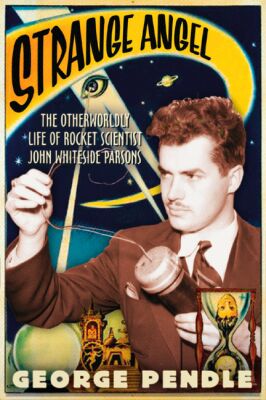

| STRANGE ANGEL The Otherworldly Life of Rocket Scientist John Whiteside Parsons George Pendle New York: Harcourt, January 2005 |
Rating: 5.0 High |
|||
| ISBN-13 978-0-15-100997-8 | ||||
| ISBN 0-15-100997-X | 350pp. | HC/BWI | $25.00 | |
When I reviewed Sex and Rockets, the first attempt1 at a biography of John Parsons, I wrote that he deserved a good biography but that the present volume was not that book. Well, folks, after reading only a few pages of it, I became convinced that the volume I now hold in my hands is that book. I still feel that way now that I've read all of it.
The book might have begun this way: "John Parsons, a self-taught chemist, was a member of the famed "Suicide Squad" that developed JATO units for the military during World War II and went on to found Aerojet Corporation, still a power in rocket manufacture." But, thanks be to God and to George Pendle, it does not. Instead, it begins with a gripping — and graphic — description of the explosion that ended John Parsons' life. Pendle's account of this accidental tragedy, and the mysteries and rumors and hints of conspiracy that flowed from it, succinctly frames Parsons' life in the contradictory milieu where he thrived and perished. Pendle ends his Introduction by describing his own perception of Parsons as a brilliant maverick who embraced both astronautics and occult rituals as pathways to the wider possibilities of the future.
Another noteworthy difference between the two biographies is that this one does much more to place Parsons in a social context, describing his parents' relationship and the fact that a wealthy grandfather enabled Parsons and his mother, after her bitter divorce, to live in Pasadena. That city played a part in shaping Parsons' personality: Celebrated worldwide as an enclave of gentility and erudition, it permitted him to indulge the rich fantasy life to which the somewhat isolated only child was prone. Parsons read avidly, devouring science-fiction tales in the "pulps". Like many other engineers and scientists, he later claimed they influenced his choice of career. But the Great Depression eroded his family's wealth. He and his mother were forced out of Pasadena, and Parsons took a job with Hercules Powder Company in northern California. Eventually he was able, with other enthusiasts, to form a fledgling rocket development group under the auspices of Dr. Theodore von Kármán at the California Institute of Technology. This group went on to become the core of CalTech's Jet Propulsion Laboratory and to found the Aerojet Corporation, still a power in rocket manufacture.
However, Parsons' hunger for involvement in large causes led him, during a quiescent period in rocket development before World War II, into association with a cult known as the OTO. He took over its chapter in southern California, renaming it Agape Lodge. This came to dominate his life, and finally (largely through the baleful influence of L. Ron Hubbard) to destroy it. Parsons did manage to wean himself off the OTO and was putting his life back together — at least a stable and productive life, if not the illustrious one befitting one of the pre-eminent pioneers of rocketry. But a rush explosives job for the Hollywood special-effects company that paid his rent in those days apparently led to a simple accident. He blew up his home lab and died. Years later, like the similarly under-appreciated Robert Goddard, he received some of the recognition due his pioneering contributions to rocketry.
Pendle's biography is diligently researched, coherent and straightforward. It neither glosses over Parsons' character flaws nor dwells on them; and it does not fill an excessive number of pages with arcane details of his "workings" (or magical endeavors) and OTO lore. Although certain periods of his life remain obscure, I attribute this to the fact that archives have disappeared, memories have faded, people have died or drifted out of contact. Pendle provides a much clearer picture of Parsons' treatment at the hands of the FBI during the Communist witch-hunt era, and of his relationship with science fiction writers like Robert Heinlein and with L. Ron Hubbard2 in particular. He also handles the technical aspects of Parsons' work much better than Carter did. Though the book has a few defects, they are minor, mostly having to do with details of Robert Goddard's life. It is, in short, an excellent portrayal of the life of a flawed but important figure in the history of American rocket technology.

 To contact Chris Winter, send email to this address.
To contact Chris Winter, send email to this address.